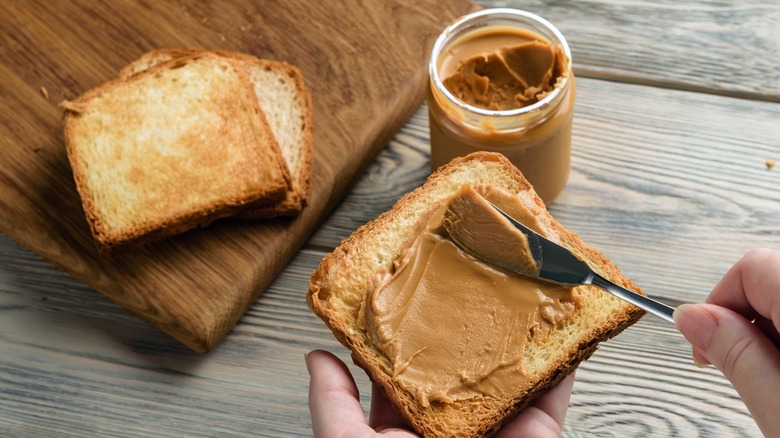What Happens To Your Blood Pressure When You Eat Lots Of Peanut Butter
Do you know your current blood pressure? When you're under stress, like when your doctor measures your blood pressure, your blood pressure could register higher. Your blood pressure also varies throughout the day, with it being highest in the middle of the day and lowest in the evening and while you sleep. Most people don't know they have high blood pressure because it doesn't come with symptoms. Yet almost half of people in the United States have high blood pressure, according to the American Heart Association.
Limiting alcohol, managing stress, exercising, and quitting smoking are some of the ways you can manage your blood pressure. If you already have high blood pressure, you've probably also been told to reduce the sodium from your diet. The American Heart Association recommends no more than 1,500 milligrams of sodium a day, and you can almost reach that amount with just ½ teaspoon of salt. If you think you have to give up peanut butter because of its sodium content, there's no need to worry. A tablespoon of regular creamy peanut butter has 76 milligrams of sodium, and the reduced-sodium version has about half that.
In addition to peanut butter being low in sodium, it also contains nutrients that are not only good for your blood pressure but also for your cardiovascular health.
How is peanut butter good for blood pressure, heart health?
A tablespoon (16 grams) of reduced-sodium peanut butter has 94 calories and just under 4 grams of protein. Despite peanut butter having 8 grams of fat, 6 of those fat grams come from heart-healthy unsaturated fat. Calcium, magnesium, and potassium are three minerals that can help manage your blood pressure, and peanut butter provides 41 milligrams of calcium, about 40% of your daily magnesium, and more than 20% of your recommended potassium.
There's also something about peanuts themselves that could reduce your blood pressure and improve your heart health. A 2014 study in The American Journal of Clinical Nutrition found that people who were already at risk for cardiovascular disease saw significant improvements in their health profile after eating 42 grams of peanuts a day for 12 weeks. Specifically, their diastolic blood pressure (the lower number) reduced on average by 5 points, and their total cholesterol and triglycerides were also lowered.
A 2022 article in Frontiers in Nutrition additionally found that adding 25 grams of peanuts a day for six months can improve your cholesterol profile. However, the group that added two tablespoons of peanut butter to their diet each day didn't see a healthy improvement in their cholesterol.
Can the oleic acid in peanut butter help blood pressure?
Peanuts and peanut butter also have a fatty acid that could lower your blood pressure called oleic acid. In a 2008 article in Proceedings of the National Academy of Sciences of the United States of America, researchers turned to the oleic acid in olive oil to see its effect on blood pressure. Olive oil has 70% to 80% oleic acid. The study found that oleic acid decreases blood pressure by affecting both the cell membranes and the signaling within the cells. Soybean oil, which has significantly less oleic acid, did not affect blood pressure.
The U.S. Department of Agriculture says that oleic acid in different brands of peanut butter can range from 19% to 27% of its total weight. In other words, peanut butter might not have a high enough concentration of oleic acid to lower your blood pressure, even if you eat a lot of it. However, the American Heart Association says people who eat peanut butter (or other nut butter) tend to have a reduced risk of heart disease and type 2 diabetes. Just be sure to stick to the more natural types of peanut butter that have fewer ingredients and no sugar.



